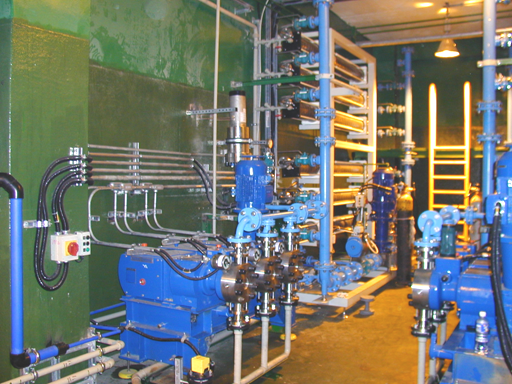Products
RODUCTS
PTotal Acid Regeneration
When using this field-tested plant engineering for the first time recovery rates for HF (total) and HNO3 (total) of far beyond 90% can be achieved. This process is applicable for mixed acid (HF/HNO3) and
(total) of far beyond 90% can be achieved. This process is applicable for mixed acid (HF/HNO3) and
metal separation rates of more than approximately 100 kg/h.
By using the Steuler SAM, SACC, SAPU - processes the free acid is recovered and returned to the pick-
ling process. The metal salts (compounds of the dissolved metal cations with respective acid anions)
are produced as byproduct or waste water flow. On the contrary in the Steuler STAR-process also the bound acid is recovered for the pickling process and the metals are utilized as metal oxides. Basis is a combination of membrane separation and thermal processes.
The Steuler STAR-process distinguishes itself by considerable advantages compared to the common
direct roaster technologies. Due to the separation of the free acid in the nanofiltration and dewatering
of slurry in the vacuum belt filter the slurry to be evaporated contains only a reduced quantity of water and nitric acid. Therefore natural gas consumption and loss of nitric acid are much lower compared to common direct roaster processes.
These advantages relating to operating costs for operators of a plant with a metal separation rate of
more than 100 kg/h result in a short payback period of approximately 1.5 years.
Process description:
First the solids contained in the waste acid, particularly undissolved scales, are filtrated by Steuler Acid Microfiltration (SAM). The filtrate is further treated in a nanofiltration membrane system: the metal
fluorides are concentrated in the concentrate flow by applying an operating pressure of up to 40 bar,
while the free acid passes through the membrane and is drained with the permeate.
The concentrate flow is discharged continuously from the nanofiltration and further concentrated in the evaporation. The heat is supplied in the form of the waste heat from the roasting process. Due to the very high metal and acid concentrations meantime, the metallic salts, mainly metal fluorides, begin to crystallize.
This crystallization is stimulated by a downstream multistage crystallization by indirectly cooling. The metal fluoride crystals are separated from
the solution by sedimentation and dewatered by vacuum belt filtration. The filtrate of the belt filter is supplied to the nanofiltration again and is thus recirculated.
The dry filter cake is mixed with little water to become a concentrated slurry and supplied to the roasting process. There the metal fluorides are converted into metal oxides by releasing gaseous HF.
The metal oxides are discharged from the roasting kiln in the waste gas flow and separated in a bag house filter.
Downstream the bag house filter the gaseous HF is absorbed in a multistage absorption column. In the lower scrubber area, designed as a packed column, the nanofiltration permeate that is poor in metals is used as an absorbent for the precleaning of the waste gases. The residual
HF is absorbed in the 2nd scrubber stage consisting of several bubble trays. As the absorbent water is used that is charged to the upper tray
and supplied in counter flow to the waste gas. The water accumulated with the hydrofluoric acid and the permeate from the nanofiltration are conveyed back to the pickling line as regenerated acid.
In order to comply with stricter legal requirements an additional flue gas purification plant can still be required. There the residual gaseous HF is absorbed by lime modules and converted into CaF2. Finally the nitrogen oxides are converted into nitrogen and water in the SCR/DeNOx stage by injecting urea or ammonia.
The Steuler STAR-process is the combination of already longtime proven processes/plants like the cross-flow microfiltration, the crystallization and the SCR/ DeNOx plant, with technologies like e. g. the nanofiltration that have not yet been applied to the regeneration of mixed acids until then. Within the development, the scope of design and the realization of the technology completely new requirements on the used materials have to be solved. As in the field of the nanofiltration the acid is conveyed via the selective membrane at a pressure of up to 40 bars. Due to the strongly oxidizing and corrosive-acting medium the suitable materials available for the used HP pumps, valves and membranes are very restricted.
After more than 3 years operation we can definitely conclude, that this challenge can be regarded as solved very well. All materials used as e. g. special stainless steels have turned out to be stable during the operation. The first industrial plant for total mixed acid regeneration and metal recovery in Taiwan has been accepted by the customer and is successfully in operation for several years.
The main benefits are:
— Considerably reduced energy consumption and loss of nitric acid
— Very high recovery rates: HF- approx. 98%, HNO3- approx. 95%
— Reduced urea consumption as reductive in the SCR/DeNOx plant
— No additional consumption of hydrogen peroxide for the NO absorption used in the waste gas cleaning
— Low concentration of fluorides in the produced metal oxides
— The modular design of both membrane units – the microfiltration for solid separation and the nanofiltration for separation and concentration of
the dissolved metals – offers a flexible operation and a high availability as well as the option to upgrade the capacity at any time.
— With a metal separation rate of more than 100 kg/h the payback period is very short (approx. 1.5 years) because of considerably savings in
operating costs